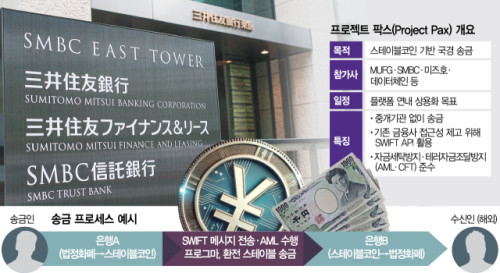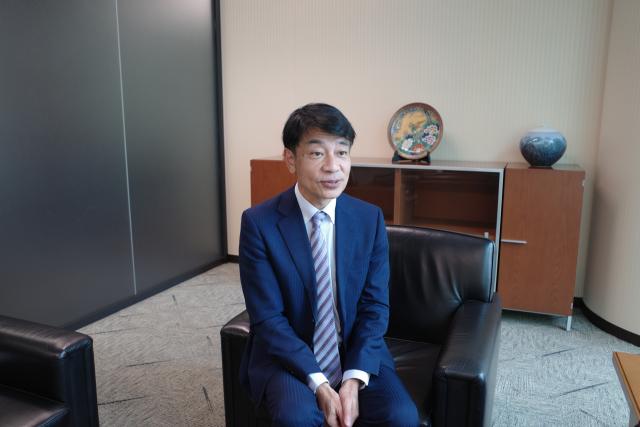
Tokyo Marunouchi, called the heart of the Japanese economy. Here, where the headquarters of Japan's three megabanks - Mitsubishi UFJ (MUFJ), Mizuho, and Mitsui Sumitomo (SMBC) are located, the 'Project Pax' targeting the global market for stablecoins is in full swing. Three major banks and IT companies have joined forces.
Yusuke Takezawa, Chief Strategy Officer (CSO) of the joint venture Progmat leading this project, met with Seoul Economic Newspaper in Tokyo on the 4th and said, "We are the only project reviewing an inter-institutional stablecoin trading system ranging from hundreds of billions to trillions of yen" and "The structure for large-scale transactions between companies is the most advanced in the world".
This means they are focusing on developing wholesale stablecoins, not retail stablecoins for payments at restaurants or shops or personal overseas remittances. The company aims to create a system that issues yen and dollar stablecoins through the 'Progmat Coin' stablecoin issuance platform and enables remittances without intermediary institutions. Takezawa emphasized that "Stablecoins mainly discussed in Korea and the US are mostly retail-oriented" and "Wholesale stablecoins are much more difficult as they must consider the entire financial system".

Progmat, a joint venture led by Japan's three megabanks - Mitsubishi UFJ Trust Bank (MUFJ), Mizuho Bank, and Sumitomo Mitsui Banking Corporation (SMBC) - is focusing on corporate stablecoin issuance and remittance platforms because they believe stablecoins can excel in inter-institutional remittances. With fast transaction speeds and low price volatility, they can be used as a stable payment and remittance method. Unlike Korea, which still considers stablecoins mainly for retail transactions or foreign exchange remittances, they are taking a step further.
Progmat's stablecoin remittance process is relatively simple. When the sender requests a remittance from their bank, the bank exchanges yen into yen or dollar stablecoins through an exchange. Progmat then transfers the exchanged stablecoins, and the receiving bank converts the received stablecoins back to fiat currency through an exchange and pays the recipient. Simultaneously, a message is sent through the SWIFT infrastructure and goes through an anti-money laundering (AML) process, ensuring safety from illegal funds.

But is there a need to use stablecoin payment settlements? Takezawa emphasized on the 4th that "The strength of stablecoins from a bank's perspective is low system investment costs" and that they can be used "much more cheaply compared to Central Bank Digital Currencies (CBDC) or deposit tokens".
CBDC is a digital currency issued by the central bank. It is guaranteed by the state and equivalent to legal tender, just circulated in digital form. Deposit tokens are issued by commercial banks and directly linked 1:1 with bank deposits, essentially digitalizing deposits. Stablecoins are issued by private companies including banks, maintaining a 1:1 reserve of fiat currency, national bonds, or cash equivalent to the issued amount, thus maintaining a fixed value.
The market analyzes that due to low investment costs, stablecoins could be widely used in developing countries in Africa and Southeast Asia. To trade with these countries, major developed nations also need to establish stablecoin systems. While CBDC might be sufficient within Japan, the US, or the EU, international transactions remain challenging.
Considering this situation, there are suggestions that major countries will need to use CBDC, deposit tokens, and stablecoins together. Takezawa advised, "When looking at the entire payment system, stablecoins won't replace everything" and that "Since CBDC, tokenized deposits, and stablecoins each have different strengths, creating an ecosystem by interconnecting them is a realistic approach".
Speed is crucial. Currently, Japan's megabanks are preparing to issue yen-linked stablecoins on Progmat's platform this year. SMBC is collaborating with blockchain company Avalabs and virtual asset security firm Fireblocks to promote stablecoin issuance, and Mitsubishi UFJ Financial Group (MUFG) is also preparing for issuance. Domestic banks like NH Nonghyup Bank, Shinhan Bank, and K Bank are currently participating in this project. Japan was the first in the world to establish stablecoin regulations in June 2022.
It's not just wholesale stablecoin issuance movements in Japan. The yen-linked stablecoin JPYC is already circulating as a retail stablecoin. Currently the only yen stablecoin existing on a public chain, it is classified as a prepaid payment method under Japanese law, essentially similar to an electronic gift card. Its circulation volume is around 2.2 billion, not extensive. However, JPYC is pursuing a funds settlement business license to transition into a true stablecoin.
Major financial group SBI is also actively entering the stablecoin business. In March this year, SBI became the first in Japan to list Circle's dollar stablecoin USDC on its exchange SBI VC Trade. They have also invested a total of $50 million in Circle.

- By Shin Jung-seop in Tokyo
< Copyright ⓒ Decenter, Reproduction and redistribution prohibited >







